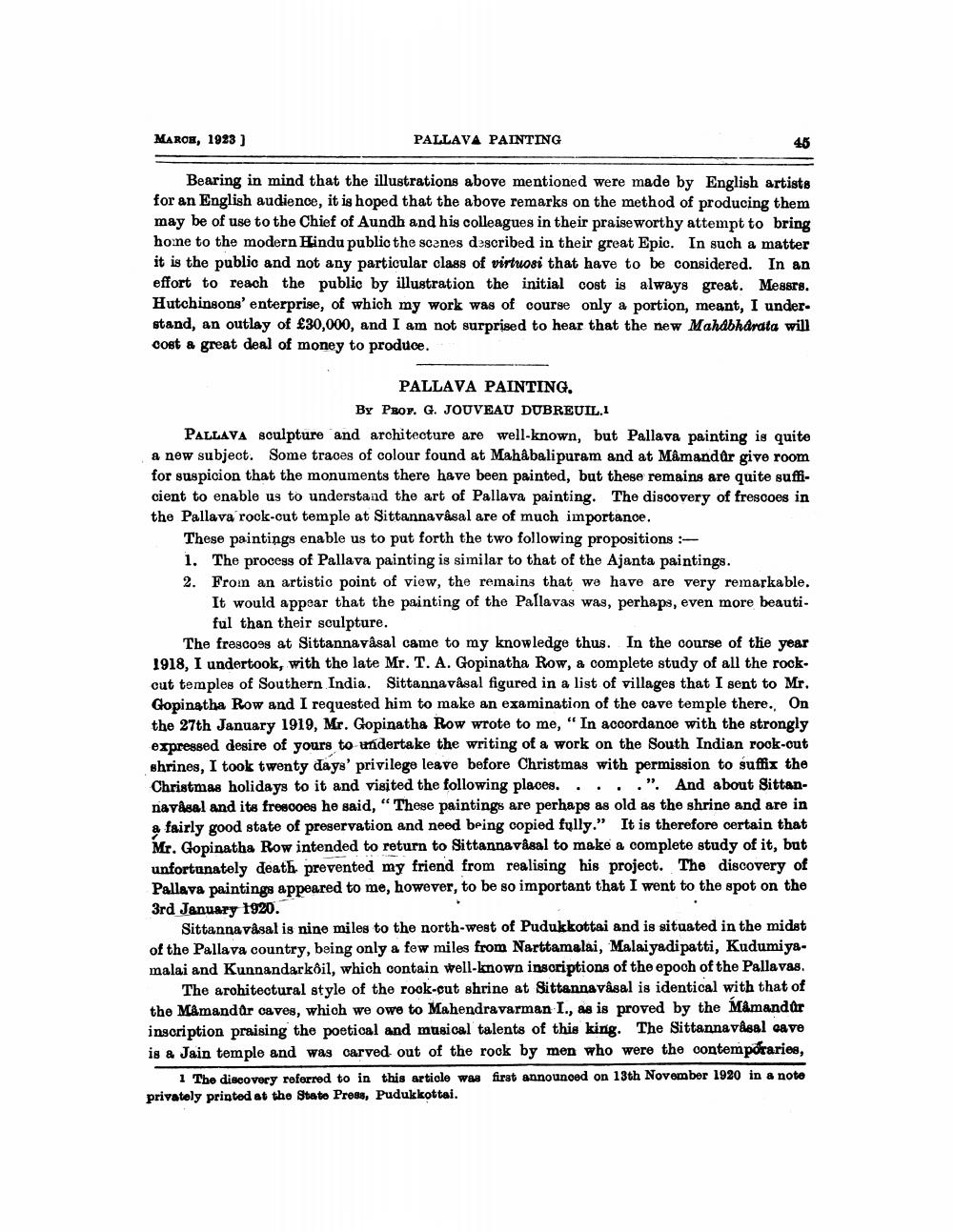________________
MAROH, 1923)
PALLAVA PAINTING
45
Bearing in mind that the illustrations above mentioned were made by English artists for an English audience, it is hoped that the above remarks on the method of producing them may be of use to the Chief of Aundh and his colleagues in their praiseworthy attempt to bring hone to the modern Hindu public the scenes described in their great Epic. In such a matter it is the public and not any particular class of virtuosi that have to be considered. In an effort to reach the public by illustration the initial cost is always great. Messrs. Hutchinsons' enterprise, of which my work was of course only a portion, meant, I under stand, an outlay of £30,000, and I am not surprised to hear that the new Mahabharata will oost a great deal of money to produce.
PALLAVA PAINTING.
By Prop. G. JOUVEAU DUBREUIL.1 PALLAVA sculpture and architecture are well-known, but Pallava painting is quite a new subject. Some traces of colour found at Mahabalipuram and at Mâmandar give room for suspicion that the monuments there have been painted, but these remains are quite sufficient to enable us to understand the art of Pallava painting. The discovery of frescoes in the Pallava rock-cut temple at Sittannavâsal are of much importance.
These paintings enable us to put forth the two following propositions - 1. The process of Pallava painting is similar to that of the Ajanta paintings. 2. From an artistic point of view, the remains that we have are very remarkable.
It would appear that the painting of the Pallavas was, perhaps, even more beauti
ful than their sculpture. The frescoes at Sittannavâsal came to my knowledge thus. In the course of the year 1918, I undertook, with the late Mr. T. A. Gopinatha Row, a complete study of all the rock cut temples of Southern India. Sittannavåsal figured in a list of villages that I sent to Mr. Glopinatha Row and I requested him to make an examination of the cave temple there. On the 27th January 1919, Mr. Gopinatha Row wrote to me, "In accordanoe with the strongly expressed desire of yours to undertake the writing of a work on the South Indian rook-out shrines, I took twenty days' privilege leave before Christmas with permission to suffix the Christmas holidays to it and visited the following places.....". And about SittannavAsal and its frescoes he said, "These paintings are perhaps as old as the shrine and are in a fairly good state of preservation and need being copied fully." It is therefore certain that Mr. Gopinatha Row intended to return to Sittannavisal to make a complete study of it, but unfortunately death prevented my friend from realising his project. The discovery of Pallava paintings appeared to me, however, to be so important that I went to the spot on the 3rd January 1920.
Sittannavåsal is nine miles to the north-west of Pudukkottai and is situated in the midst of the Pallava country, being only a few miles from Narttamalai, Malaiyadipatti, Kudumiyamalai and Kunnandarkðil, which contain well-known inscriptions of the epoch of the Pallavas.
The arohitectural style of the rock-cut shrine at Sittannavåsal is identical with that of the Mamandør caves, which we owe to Mahendravarman I., as is proved by the Mamandir inscription praising the poetical and musical talents of this king. The Sittannavdeal cave is & Jain temple and was carved out of the rock by men who were the contemporaries,
1 The discovery referred to in this article was first announoed on 13th November 1920 in a note privately printed at the State Press, Pudukkottai.




